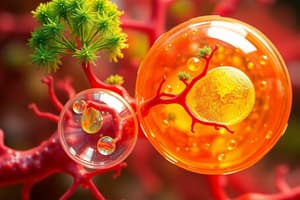Podcast
Questions and Answers
What is the title of Chapter 1?
What is the title of Chapter 1?
- The Chemistry of Life
- The Science of Biology (correct)
- Cell Structure and Function
- The Biosphere
What is the title of Chapter 2?
What is the title of Chapter 2?
- Cytokinesis in Animal Cells
- Photosynthesis
- The Chemistry of Life (correct)
- The Science of Biology
What is the title of Chapter 3?
What is the title of Chapter 3?
- Human in the Biosphere
- Ecosystems and Communities
- The Biosphere (correct)
- Cell Growth and Division
What is the title of Chapter 4?
What is the title of Chapter 4?
What is the title of Chapter 5?
What is the title of Chapter 5?
What is the title of Chapter 6?
What is the title of Chapter 6?
What is the title of Chapter 7?
What is the title of Chapter 7?
What is the title of Chapter 8?
What is the title of Chapter 8?
What is the title of Chapter 9?
What is the title of Chapter 9?
What is Cell Growth and Division?
What is Cell Growth and Division?
What occurs during Cytokinesis in Animal Cells?
What occurs during Cytokinesis in Animal Cells?
What occurs during Cytokinesis in Plant Cells?
What occurs during Cytokinesis in Plant Cells?
Why is the surface area of a cell important?
Why is the surface area of a cell important?
What happens to the ratio of surface area to volume as cell size increases?
What happens to the ratio of surface area to volume as cell size increases?
How does photosynthesis differ from cellular respiration?
How does photosynthesis differ from cellular respiration?
What is the source of quick energy during exercise?
What is the source of quick energy during exercise?
What is a characteristic of short-term energy during exercise?
What is a characteristic of short-term energy during exercise?
What is the main source of long-term energy during exercise?
What is the main source of long-term energy during exercise?
Flashcards are hidden until you start studying
Study Notes
The Science of Biology
- Introduces basic concepts and principles guiding biological study and inquiry.
The Chemistry of Life
- Explores molecular composition and biochemical processes vital for life, including the roles of carbohydrates, proteins, lipids, and nucleic acids.
The Biosphere
- Discusses Earth's diverse ecosystems and how biological, chemical, and physical factors interact within life zones.
Ecosystems and Communities
- Examines the interactions between organisms and their environments, including predator-prey dynamics and competition.
Populations
- Focuses on population dynamics, including growth rates, carrying capacity, and factors affecting population sizes.
Humans in the Biosphere
- Analyzes the impact of human activities on ecosystems, biodiversity, and the environment, emphasizing sustainability.
Cell Structure and Function
- Describes cellular components and their functions, highlighting differences between prokaryotic and eukaryotic cells.
Photosynthesis
- Details the process by which autotrophic organisms convert light energy into chemical energy, producing glucose and oxygen.
Cellular Respiration and Fermentation
- Explains how cells break down glucose to release energy, covering aerobic respiration, anaerobic processes, and the importance of fermentation.
Cell Growth and Division
- Investigates the processes of cell growth, division, and the regulation mechanisms involved to maintain healthy cellular function.
Cytokinesis in Animal Cells
- Describes how the cell membrane is pinched inward to separate the cytoplasm into two daughter cells post-mitosis.
Cytokinesis in Plant Cells
- Details the formation of a cell plate that develops into the cell wall, ensuring division into two distinct plant cells.
Importance of Surface Area of Cell
- Highlights how increased surface area enhances nutrient uptake and waste removal, essential for cellular efficiency.
Ratio of Surface Area to Volume
- Explains that as cell volume increases, its surface area grows at a slower rate, impacting efficiency in exchange processes.
Photosynthesis vs. Cellular Respiration
- Contrasts two processes: photosynthesis absorbs CO2 and releases O2, while cellular respiration uses O2 and emits CO2.
Exercises and Energy: Quick Energy
- Describes the reliance on stored ATP for immediate energy needs, suitable for short, intense activities.
Exercises and Energy: Short Term Energy
- Focuses on lactic acid fermentation as a quick ATP source for moderate-intensity exercise lasting up to 90 seconds.
Exercises and Energy: Long Term Energy
- Discusses the reliance on cellular respiration to sustain energy for prolonged activities after initial glycogen stores are depleted, transitioning to fat metabolism.
Studying That Suits You
Use AI to generate personalized quizzes and flashcards to suit your learning preferences.




